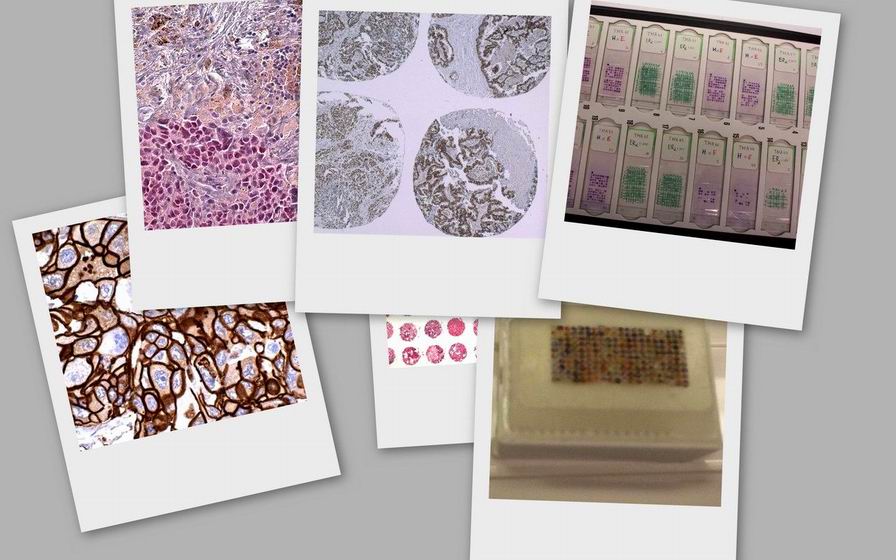| tkachenkocat | Дата: Четверг, 2013-03-07, 6:00 PM | Сообщение # 1 |
|
Лейтенант
Группа: Проверенные
Сообщений: 10
Статус: Offline
| Пишу научную работу по диагностике опухолей щитовидной железы. Располагаю только ИГХ- маркерами на кальцитонин, хромогранинА и тиреоглобулин. Появились трудности с формулировкой и пониманием актуальности использования хромограниаА и ТГ в диагностике РЩЗ... С кальцитонином всё понятно: диагностика Медуллярного РЩЗ. ХромогранинА является нейроэндокринным маркером, но с какой целью его используют для диагностики? Не могу разобраться. В литературе найти ничего не могу. Это касается и ТГ. Нашла информацию, что данный маркер можно использовать для диагностики различных вариантов папиллярного РЩЗ и для диагностики фолликулярного РЩЗ. А как он используется для диагностики фолликулярного РЩЗ? Какова его ценность именно в данной диагностики? Для отличия доброкачественности от злокачественности? Таких данных я не нашла.. Помогите, пожалуйста.
|
| |
| |
| Vladpatholog | Дата: Суббота, 2013-03-09, 5:16 PM | Сообщение # 2 |
 Генерал-лейтенант
Группа: Администраторы
Сообщений: 638
Статус: Offline
| многое можно написать о роли игх в диагностике раков щитовидной железы и многое о бесполезности этой самой диагностики на практике. конечно когда речь идет о метастазах без пво, то роль вполне понятная и даже в пределах указанного спектра антител.А вотчто касается диф.диагностики рака и аденом - было написано много со многими довольно редкими антителами, но на практике - ничего достойного так и не появилось. хороший пример - предыдущее издание книги Семена Венедиктовича в котором приведена лаконичная схемка такой диф.диагностики и его же современные лекции с перечеркнутой этой же схемой как не оправдавшей надежд. вообще с папиллярными раками собственно в щитовидке проблем обычно и гистологически нет, а если метастаз достаточно - vmentin, ck7, ttf1, chromogranin. А если гворить о фолликулярных раках, то указанная паель маловероятно, что даст какой-то результат. да и вообще в этой проблеме больше вопросов чем ответов.
с уважением.
писал с планшета - вот корявенько и вышло.
|
| |
| |
| Maxim | Дата: Суббота, 2013-03-09, 8:42 PM | Сообщение # 3 |
|
Профессионал
Группа: Модераторы
Сообщений: 555
Статус: Offline
| Очень исчерпывающее руководство по щитовидке, правда на наглийском. Можно выкачать в сети.
Diagnostic Pathology and Molecular Genetics of the Thyroid, 1st Edition
Editors: Nikiforov, Yuri E.; Biddinger, Paul W.; Thompson, Lester D.R.; Nikiforova, Marina N.; Biddinger, Paul W.
Copyright ©2009 Lippincott Williams & Wilkins
Mills S Histology for Pathologists, 3rd Edition (Гистология дл патологов) пишет вот что о маркерах для щитовидки
Immunohistochemistry
A wide variety of markers with various degrees of specificity and diagnostic significance are expressed by the normal adult follicular cells.
Thyroglobulin (TGB)
This is the most specific immunohistochemical marker for normal follicular cells and the tumors composed of them. It can be demostrated with either monoclonal or polyclonal antibodies and the reactivity is both in the cytoplasm and in the colloid (37,38). Oncocytes show a much lesser degree of positivity. Despite its high specificity, TBG can give rise to a common pitfall. Because of its tendency to leak out of the cytoplasm of the follicular cells and to diffuse into the adjacent tissues, where it can then be incorporated into the cytoplasm of other types of cells (e.g., metastatic carcinoma), it can cause a false positivity (39).
Thyroid Transcription Factor-1 (TTF-1)
This is another very useful marker for thyroid follicular cells and tumors composed of them. This nuclear transcription factor, first identified in thyroid follicular cells and later in pneumocytes, is necessary for the development of thyroid and pulmonary tissues. In the normal adult thyroid its distribution is related to that of thyroglobulin and thyroperoxidase (40,41).
Keratins
Normal follicular cells are immunoreactive only for low-molecular-weight keratin, whereas high-molecular-weight types have been found to be expressed in inflammatory and neoplastic conditions (42,43,44).
Vimentin
Some normal follicular cells occasionally express this intermediate filament in conjunction with keratin, although less commonly than in neoplastic conditions (45).
Epithelial Membrane Antigen (EMA)
Follicular cells are variably positive, with accentuation of the cell membranes.
Triiodothyronine (T3) and Thyroxine (T4)
These hormones can be detected immunohistochemically both in the cytoplasm of the follicular cells and in the intraluminal colloid but their use for diagnostic purposes is negligible.
Estrogen and Progesterone Receptors
Estrogen and progesterone receptors positivity, restricted to the follicular cell nuclei, shows some correlation with the age and sex of the individual (46,47).
P.1135
S-100 protein
This marker, which is mainly detected in inflammatory/hyperplastic and neoplastic thyroid conditions, is only focally and weakly expressed by normal follicular cells (48,49).
Epidermal Growth Factor Receptor (EGFR)
In normal follicular cells, and because of their functional polarization, the location of this receptor is mainly basal or basolateral (50).
Thyroid Peroxidase
This enzyme is responsible for the oxidation of iodide to iodine. At the immunohistochemical level it shows a pattern of staining correlated with the age of the individual. A cytoplasmic pattern of staining with apical membrane accentuation is seen in children and young adults, and a perinuclear ring distribution is seen in older individuals (51).
Sodium Iodide Symporter
At the immunohistochemical level this molecule, responsible for the active iodide intake into the follicular epithelium, is localized mainly to the lateral basal portion of the cells (52,53
Наберите, в конце концов ссылку на книгу Immunohistochemistry vade-mecum 2012 в гугле и там сможете найти ответы на все вопросы, включая ссылки на последние и фундаментальные книги и статьи. Там тоже много интересного и не только о щитовидке. Там есть посик по антителам, по опухолям и т.п.
www.pathologyuotlines.com тоже содержит море свяких ссылок и описаний.
Ну это так, что пришло быстро на ум.
|
| |
| |
| tkachenkocat | Дата: Суббота, 2013-03-09, 11:43 PM | Сообщение # 4 |
|
Лейтенант
Группа: Проверенные
Сообщений: 10
Статус: Offline
| Большое спасибо за помощь и понимание. Обязательно воспользуюсь Вашими советами. Спасибо.
|
| |
| |

